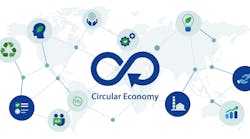Environmental product declaration program operator Smart EPD has announced a call for participation to develop a North American product category rule (PCR) for luminaires. Interested parties from the lighting community should submit applications to serve on the PCR committee by Oct. 27, 2023.
Why participate?
According to the U.S. General Services Administration (GSA), PCRs are “a set of rules and guidelines for developing [environmental product declarations] for a specific product or type of product.” PCRs are developed via collaboration between program operators and industry stakeholders, who help to draft, revise, and approve the PCR through a process similar to that of industry consensus standards.
Pacific Northwest National Laboratory (PNNL) energy and environment scientist Kate Hickcox reached out to LEDs Magazine to summarize the influence a PCR may have on the lighting industry. “PCRs determine how embodied carbon and other environmental impacts are calculated for lighting products,” Hickcox said via email. “[They] establish a level playing field for industry to report product environmental performance and enable the development of EPDs that specifiers and buyers can use to compare and select more environmentally friendly products,” she explained.
As a lighting scientist, educator, and designer, Hickcox has applied to participate in the PCR committee established by Herdon, Va.–based Smart EPD, and encourages other lighting professionals and academics to apply to participate before the October deadline.
Smart EPD founder and CEO Anna Lasso elaborated on reasons for the lighting industry to get behind such a PCR development effort. “While EPDs are primarily driven by voluntary green building schemes such as LEED, they are increasingly being required by U.S. state and federal ‘Buy Clean Policy’ initiatives for certain product categories,” Lasso explained. “This PCR will provide the methodological consistency needed for LCAs and resulting EPDs to be comparable and support [such] policies,” which she emphasized are “not only requiring EPDs for public procurement but […] establishing environmental performance benchmarks and where the worst performers will not be eligible for procurement.”
What is an environmental product declaration?
“EPDs are Type III environmental declarations (following ISO 14025) that communicate standardized environmental information about the lifestyle impact of a product. EPDs are independently verified and registered documents based on industry standard product category rules (PCRs), but having an EPD does not imply that the declared product is environmentally superior to alternatives. An EPD reports a specific set of environmental results which can only be created after a full LCA [life cycle assessment] is conducted. Common impact categories include global warming potential (GWP), ozone depletion potential, acidification potential, eutrophication potential, smog formation potential, and primary energy use.” — From U.S. General Services Administration Sustainable Facilities Tool website
Ultimately, an EPD enables a manufacturer to distill complex information regarding its product’s life cycle assessment into standardized declaration labels to aid specifiers and buyers in sourcing products that meet their project’s/client’s environmental requirements.
LCA roadmap
During LEDucation in New York City this past March, LEDs found that LCA incubator efforts we first learned about in 2022’s virtual presentations were making headway toward simplifying the suggested practices. Amid concerns from luminaire manufacturers in the audience that the added cost and time required to comply with requests for sustainability data would reduce suppliers’ agility and slow both product and project design cycles, 2023 LCA session speakers Leela Shanker, Russell Greenberg, and Hickcox summarized lessons learned by incubator participants and shared progress toward streamlining data collection across the industry. This includes determining appropriate specifications and metrics to employ, setting benchmarks, and standardizing LCA methods so that resulting EPDs can be relied upon to meet building rating, certification, and regulatory objectives.
In our recent exchange, Hickcox specified that PNNL is “working with many lighting industry stakeholders including manufacturers, specifiers, academics, and LCA practitioners to develop [a luminaire-specific LCA data-collection] template for the lighting industry to help to remove barriers to achieving high-quality, transparent, and comparable LCAs and EPDs.” Although the current template is modeled after an existing European-based PCR, Hickcox said the LCA collaborators would be able to align their efforts with the upcoming North American PCR.
Several organizations — including ETC, Finelite, Lantana LED, Lightly, Signify, Vode Lighting, and the National Electrical Manufacturers Association (NEMA) — are co-sponsoring the PCR, which affords them a representative on the committee while “demonstrating their sustainability leadership to the lighting community,” Lasso pointed out.
Readers can send inquiries regarding the PCR process to [email protected], and visit the Smart EPD website to apply prior to Oct. 27.
CARRIE MEADOWS is editor-in-chief of LEDs Magazine, with 20-plus years’ experience in business-to-business publishing across technology markets including solid-state technology manufacturing, fiberoptic communications, machine vision, lasers and photonics, and LEDs and lighting.
Follow our LinkedIn page for our latest news updates, contributed articles, and commentary, and our Facebook page for events announcements and more. You can also find us on the X platform.





